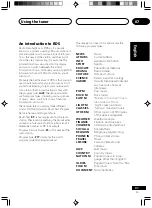
Setting up the receiver
06
33
En
• If you chose the small front speaker
setting,
SW YES
is automatically set and
locked.
• You can only select the
PLUS
setting if the
front speakers are set to
L
.
Crossover frequency setting
• Default setting:
100 Hz
Crossover frequency is the point where the
receiver divides the high and low sounds (the
frequencies) between the speakers. Since most
smaller speakers can’t handle deep bass tones,
you can send these sounds to the subwoofer (or
if you don’t have a subwoofer, the large (
L
)
speakers in your system) instead of the
speakers set to small (
S
) in your setup. Choose
the point at which you want the frequency
routed to the subwoofer (or
L
speakers).
We recommend setting this to
200 Hz
if your
S
speakers are smaller bookshelf-type speakers.
•
Use
’
or
‘
to specify the crossover
frequency for your small speakers:
100 Hz
Sends bass frequencies below 100 Hz to the
subwoofer (or
L
speakers).
150 Hz
Sends bass frequencies below 150 Hz to the
subwoofer (or
L
speakers).
200 Hz
Sends bass frequencies below 200 Hz to the
subwoofer (or
L
speakers).
If all speakers (front, center, and surround)
are set to
L
, the crossover frequency can’t be
set because there are no
S
speakers (
appears in the display).
LFE attenuator setting
• Default setting:
0 dB
Dolby Digital and DTS audio sources include
ultra-low bass tones. Set the LFE attenuator as
necessary to prevent the ultra-low bass tones
from distorting the sound from the speakers.
•
Use
’
or
‘
to set the attenuation level
(0 dB, 10 dB or
dB(
∞
)).
0 dB
10 dB
∞
(displays
)
When
∞
is selected (
appears in the
display), LFE is not available.
Front speaker distance setting
• Default setting:
3 m
Sets the distance from the front speakers to the
listening position.
•
Use
’
or
‘
to set the distance of the
front speakers from the main listening
position (within a range of 0.1 m to 9.0 m).
















































